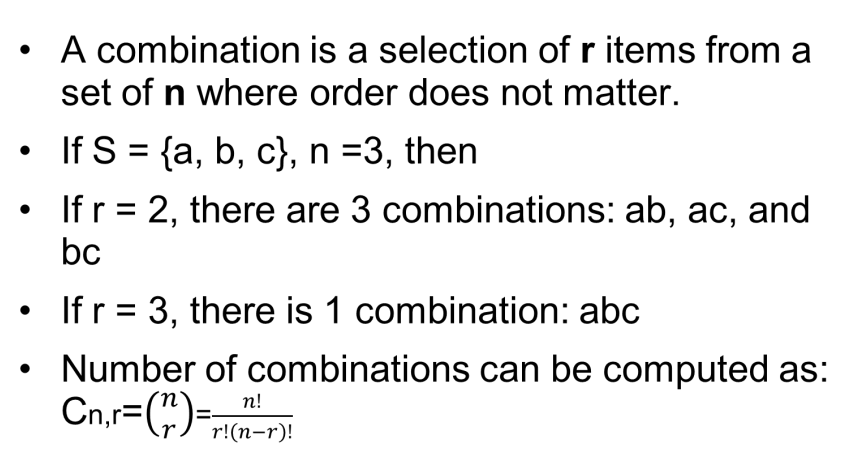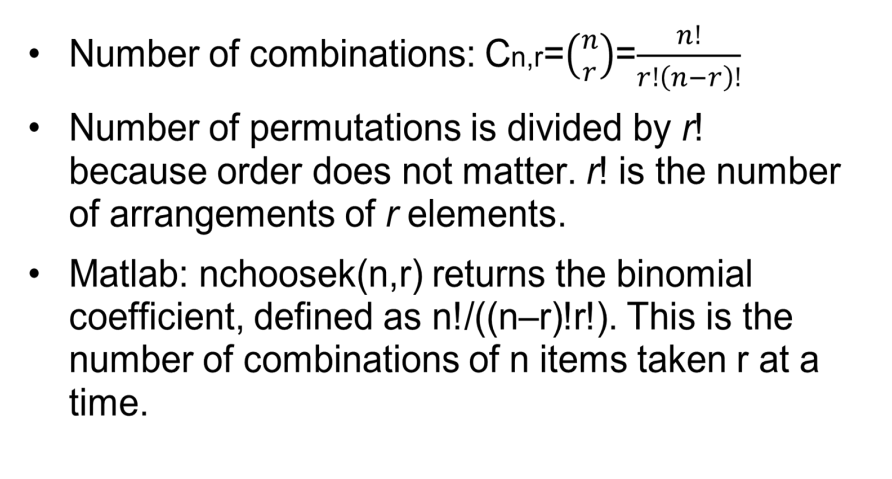04
-

-
“Oil Industry Drills Data with Deep Learning”
- http://www.electronicdesign.com/industrialautomation/oil-industry-drills-data-deep-learning
- “Oil and gas companies are in the data business as much as they are in the hydrocarbon business,” said Mathew Binu, global head of digital products at Baker Hughes
- “To stay ahead of the competition, they need to derive insights from the massive amounts of sensor, geolocation, weather, drilling and seismic data they generate.”
Lecture 3
- Counting – multiplication (product),
- permutation and combination rules
- Factorial
- Binomial coefficient
-
Counting
- There are three counting techniques which are used to determine the number of outcomes in events.
• Multiplication (product) rule
• Permutation rule
• Combination rule
- Each technique must be applied properly in order to perform counting correctly
Product (Multiplication) Rule
- Consider a procedure which involves k steps and there are
• n1 ways of completing step 1,
• n2 ways of completing step 2,
• …
• nk ways of completing step k.
- What is the total number of ways to performs those k steps?
- Total number of ways to perform those k steps is:
- • n1 · n2 · … · nk
- This result is known as a product (or multiplication) rule.
- Can be visualised with a tree diagram
Product rule: example
- For widget design, there are 4 colours, 5 sizes, and 2 different materials to choose from. Determine how many designs are possible.
- Direct application of product rule gives the following answer: 4 · 5 · 2 = 40
- Observation: more steps and/or more ways of completing each step rapidly increase total number of ways
• Doubling of ways of each step will result in 8 times higher number of total designs: 8 · 10 · 4 = 320
Permutations rule
- Suppose that we are given n distinct objects and wish to arrange r of these objects in a line.
- nPr = n(n - 1)(n - 2)... (n - r +1)
- Since first object can be picked n ways, second (n-1) and r-th can be chosen in (n-r+1) ways
Permutations: factorial
- A permutation is a unique, ordered sequence of distinct items (when n=r on previous slide)
- Number of permutations for a set of n items is n! where n! = n·(n-1)·(n-2)·…·2·1
• Special case: By definition: 0! = 1 (not 0)
- 5! = 5·4·3·2·1 = 120
• factorial(n) in Matlab
Permutations: examples
- If S = {a, b, c}, then there are 3!=1 · 2 · 3=6 permutations:
abc, acb, bac, bca, cab, cba
- Number of permutations grows very fast with n: For example, 26 different letters can be arranged in 26! ways.
Note that 26!=403291461126605635584000000. In other words, 26! happens to be a 27 digit number.
Rapid Increase of Factorial
- 1!=1
2!=2
3!=6
4!=24
5!=120
6!=720
7!=5,040
8!=40,320
9!=362,880
10!=3,628,800
11!=39,916,800
12!=479,001,600
13!=6,227,020,800
Permutations with identical elements
- Suppose that a set consists of n elements of which n1 are of one type (i.e., indistinguishable from each other),
n2 are of a second type,..., and nk are of a k-th type so that n=n1+n2+...+nk.
- Then the number of different permutations of these elements is - n!/(n1!n2!...nk!)
Permutations with identical elements: example
- Determine the number of different permutations of letters S,I,N,A,N,O,V,I,C
- Click here to view the solution
Combinations vs Permutations
- In a permutation, we are interested in the specific order of arrangement of the objects.
For example, abc is a different permutation from cba.
- In combinations, we are interested only in selecting objects without regard to order.
Such selections are called combinations. For example, abc and bca are the same combination (but different permutation)
Combinations: simple example and formula

Combinations

Solutions: Permutations with identical elements: example
• 9 letters: 2 I's and 2 N's, rest unique
• Then the number of different permutations of theses objects is 9!/(2!2!)=9!/4=90,720 - There are three counting techniques which are used to determine the number of outcomes in events.
-
Pascal’s Triangle and Binomial Coefficients
- Row number n contains the binomial coefficient Cn,r for r = 0,…,n.
- Pascal’s triangle allows the quick calculation of binomial coefficients.
- Example: By observing row number 5 of the triangle, one can easily see that (each number is sum of two numbers above it):
(x + y)5 = 1 x5 + 5 x4y + 10 x3y2 + 10 x2y3 + 5 x y4 + 1 y5

Combinations
- Remember that nPr = n(n - 1)(n - 2)... (n - r +1)
- We can think of combinations as
Cn,r = nCr = nPr /r!
because r objects have orderings which do not matter
- Example: The number of ways in which 3 machine parts can be chosen from a total of 8 different machine parts is …?
Choosing Machine Parts example
- The number of ways in which 3 machine parts can be chosen from a total of 8 different machine parts is:
8C3 = 8!/(3!*5!)=8*7*6/(1*2*3)=56
Combinations: byte example
- Example: Byte has 8 bits. Each bit has either 0 or 1 value.
a) Find the number of different bytes.
b) Find the number of bytes which have exactly two ones.
Combinations: byte example (solution)
- a) Product (multiplication) rule: 2^8=256
b) The number of ways in which 2 bits can bechosen from a total of 8 bits
8C2 = 8!/(2!*6!)=8*7/(1*2)=28